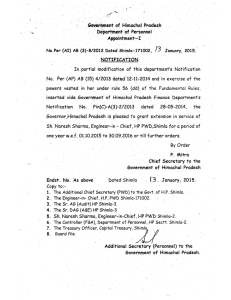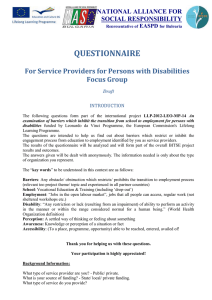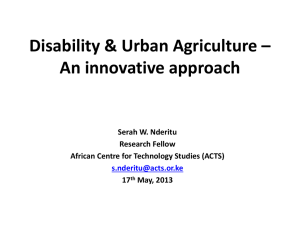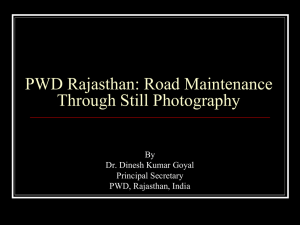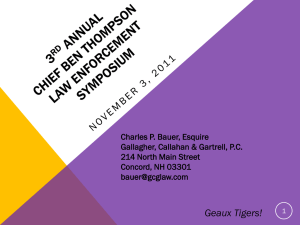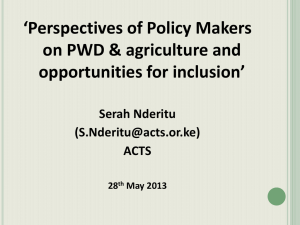PWD IN AGRICULTURE IN KENYA: ACCESS TO RESOURCES AND TRAINING
advertisement
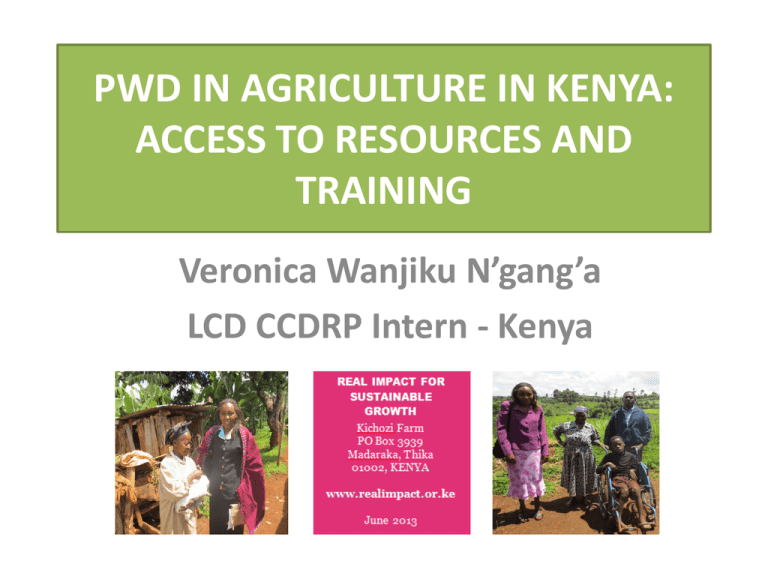
PWD IN AGRICULTURE IN KENYA: ACCESS TO RESOURCES AND TRAINING Veronica Wanjiku N’gang’a LCD CCDRP Intern - Kenya INTRODUCTION Veronica Wanjiku Experience teaching hearing impaired and group leadership Hearing Impaired BSc and PGD in Education MOTIVATION PERSONAL EXPERIENCE TO ACQUIRE RESEARCH SKILLS TO ACQUIRE EXPERIENCE ON INCLUSION OF PWD IN AGRICULTURE EXPERIENCES AS A LEADER IN A GROUP OF HEARING IMPAIRED PERSONS AIMS OF THE PROJECT 1 2 •To improve PWD access to agriculture by assessing current agricultural involvement •To make recommendations for a PWD nutrition garden, demonstration plot and training materials OBJECTIVES To conduct interviews and questionnaires with PWD to determine the barriers they face Identify categories of persons with disabilities in agriculture To determine attitudes of PWD in agriculture Developing inclusive training programmes to support nutrition garden training (eg. training manuals) Identify which farming activities can be carried out by different categories of PWD and where support will be needed Recommendations for a PWD nutrition garden training plot at Kichozi farm METHODOLOGY Identify groups of PWD to survey Data Analysis Ensure wide area coverage – Thika and beyond Carry out site visits at individual farms – administer questionnaire Ensure group samples includes different disabilities, gender and age Draft questionnaires PRELIMINARY RESEARCH FINDINGS All categories of PWD can carry out some task in agriculture contrary to the belief that PWD cannot or have a significantly reduced ability to participate All categories of PWD are involved in agriculture to different extents Lack of supportive infrastructure Lack of selfesteem Barriers to Participation Lack of farming skills & knowledge The majority of PWD have a positive attitude towards agriculture Inadequate land & land ownership Inadequate capital CASE STUDY Madam XX (physically impaired) is 27 years old. She was abandoned by her daughter’s father due to her disability, she cares for the child alone. She is not employed but has an interest in agronomy. Her parents did not give her any portion of family land to carry out farming activities. She has an interest in growing lots of passion fruit for sale but lacks land, water and capital. She has established a seedling nursery, seedlings are now ready to transplant. She is forced to sell the seedlings at a loss due to lack of her own land to transplant. RECOMMENDATIONS Animals: low capital and low labour (rabbits) Crops: not labour intensive, easy to grow (bag gardens) Farming tools must be small and light Real Impact PWD plot Explanation cards including in braille and simple diagrams Wide access paths Assistive devices: wheelchairs, ramps, white canes, interpreters RECOMMEDATIONS CONTD.’ Training Develop & adapt training materials for PWD Make environment accessible to PWD (ablution block, training rooms, dining rooms etc.) Modify training courses to include topics such as: self-esteem, farm mobility, resource mobilisation and record keeping Highlight agronutrition for different categories of PWD THE WAY FORWARD PWD in Agriculture More research needed to assess involvement of PWD in agriculture across additional locations Establish demonstration plots within PWD communities and localities Develop the Real Impact demonstration plot into a Centre of Excellence for referrals and training Continuous development of training and provision of extension services across sectors WHAT HAVE I GAINED? Practical research skills Improved selfconfidence Exposure-Am ready to undertake masters if sponsored Made important contacts Knowledge on existing gaps in research VERONICA WORKING AT HER VEGETABLE GARDEN THANK YOU CONTACTS • NAME: VERONICA WANJIKU NG’ANG’A • EMAIL: veronganga04@yahoo.com • MOBILE PHONE:+254725822329(SMS ONLY)

